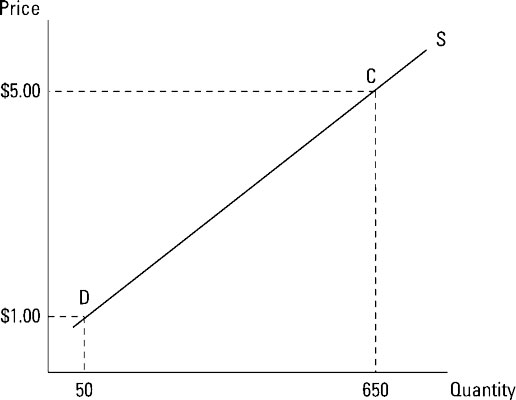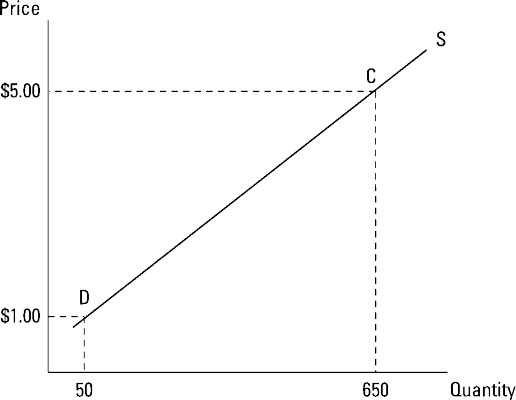Market Leather Event the Price of Beef Changes Chegg
Supply describes the economic relationship between the adept'southward price and how much businesses are willing to provide. Supply is a schedule that shows the relationship between the practiced's price and quantity supplied, property everything else constant.
Holding everything else constant seems a little ambitious, even for economists, just there is a reason for that qualification. By holding everything else constant, supply enables you to focus on the relationship between price and the quantity provided. And that is the disquisitional human relationship.
The difference between quantity supplied and supply
You must exist able to distinguish between two terms that sound the same, quantity supplied and supply, just hateful very dissimilar things. It is common for others not to brand the distinction and as a result their analysis is confused.
Quantity supplied refers to the amount of the skillful businesses provide at a specific price. And then, quantity supplied is an actual number. Economists utilise the term supply to refer to the entire curve. The supply bend is an equation or line on a graph showing the dissimilar quantities provided at every possible toll.
How to graph supply
The supply curve's graph shows the relationship between toll and quantity supplied. When the price is very high, businesses provide a lot more than treats. At that place's money to be made. But if the toll is very depression, there's not much money to exist made, and businesses provide fewer of the item.
For instance, if the toll of dog treats is $5.00, businesses provide 650 boxes of treats a calendar week. On the other hand, if the price of treats decreases to $1.00 a box, the quantity of treats provided decreases to 50 boxes a week.
Price changes
Price and quantity supplied are direct related. As price goes down, the quantity supplied decreases; equally the price goes up, quantity supplied increases.

Price changes cause changes in quantity supplied represented by movements along the supply curve. When the price of dog treats decreases from $5.00 to $1.00, the quantity supplied decreases from 650 to l boxes per week — a movement from point C to betoken D on the supply bend. This movement indicates that a direct relationship exists between cost and quantity supplied: Price and quantity supplied move in the same direction.
Supply curve shifts
When economists focus on the relationship between price and quantity supplied, a lot of other things are held constant, such equally production costs, applied science, and the prices of appurtenances producers consider related. When any ane of these things changes, the entire supply bend shifts.
If an increment in supply occurs, the curve shifts to the right. In this case, an increase in supply shifted the curve from Southward0 to Sone. As a result, more domestic dog treats are provided at every possible price. For case, at a price of $5.00, 750 boxes of dog treats are provided each calendar week instead of 650.
A rightward shift in the supply curve always indicates an increment in supply, while a leftward shift in the curve indicates a decrease in supply.

The factors that shift the supply curve include
-
Production costs: Input prices and resulting product costs are inversely related to supply. In other words, changes in input prices and production costs crusade an contrary modify in supply. If input prices and production costs increase, supply decreases; if input prices and product costs decrease, supply increases. For example, if wages or labor costs increase, the supply of the adept decreases.
-
Technology: Technological improvements in production shift the supply bend. Specifically, improvements in technology increase supply — a rightward shift in the supply curve.
-
Prices of other goods: Price changes for other goods are a fiddling complicated. Starting time, in club to affect supply, producers must think the appurtenances are related. What consumers think is irrelevant. For example, ranchers think beef and leather are related; they both come up from a steer. However, customers don't want to eat leather for dinner.
Beefiness and leather are an example of articulation products, products produced together. For joint products, a direct relationship exists between a skillful'south price and the supply of its joint production. If the cost of beef increases, ranchers raise more than cattle, and the supply of beef'southward joint product (leather) increases.
Producer substitutes too exist; using the same resource, a business can produce i skilful or the other. Corn and soybeans are examples of producer substitutes. If the price of corn increases, farmers abound more than corn, and less state is available to grow soybeans. Soybeans' supply decreases. An changed relationship exists betwixt a good's cost (corn) and the supply of its producer substitute (soybeans).
About This Article
This article can be found in the category:
- Economic science ,
Source: https://www.dummies.com/article/business-careers-money/business/economics/the-economic-relationship-between-quantity-supplied-and-prices-167057/
0 Response to "Market Leather Event the Price of Beef Changes Chegg"
Post a Comment